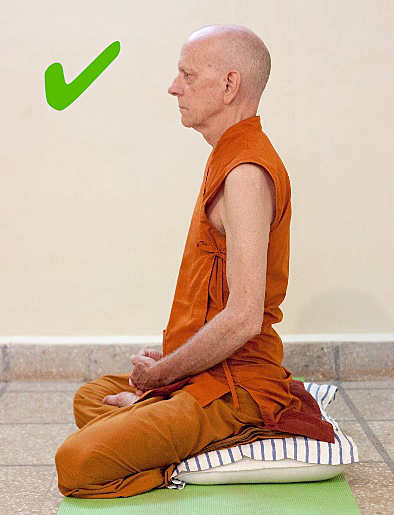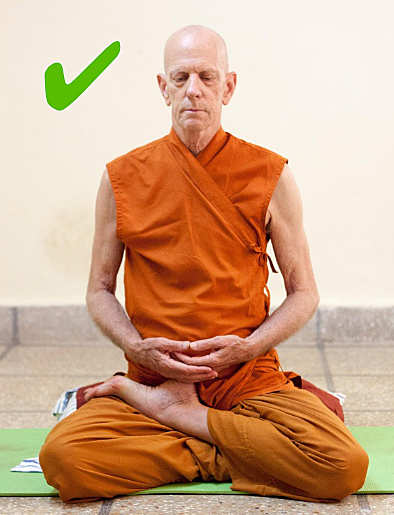The following meditation exercise is given for those who may not already be practicing a form of meditation, who do not have the guidance of a teacher, or for those who may just want to see what this meditation is all about. For it’s only through actually tuning one’s awareness to the present moment of experience, that insight and direct knowledge gradually unfolds.
If possible try to do a few yoga stretches first. For beginners, it is helpful to find a place to sit where it is fairly quiet and comfortable. Sit on a cushion so that your buttocks are raised higher than the knees with the back and head straight but relaxed, not rigid. Place the hands comfortably in the lap and gently close the eyes.



Begin by doing a few rounds of deep, slow breathing, feeling the movements of the expansion and contraction of the abdomen/ribcage/chest area. Then discontinue the controlled breathing and let the breath return to its natural rhythm. Now develop and feel a genuine loving-friendliness and compassion for all living beings, wishing them happiness and freedom from suffering. You could use this following set of handy phrases:
May I be free from greed, hatred, fear and delusion;
May I live peacefully and harmoniously in myself and with others;
May I have the patience, strength, mindfulness, and wisdom to meet and overcome all difficulties in life;May my parents, family relatives, teachers and good friends be free from greed, hatred, and delusion;
May they live peacefully and harmoniously in themselves and with others;
May they have the patience, strength, mindfulness, and wisdom to meet and overcome all difficulties in life;May all other living beings also be free from greed, hatred and delusion;
May they live peacefully and harmoniously in themselves and with others;
May they have the patience, strength, mindfulness, and wisdom to meet and overcome all difficulties in life.May all beings be well, peaceful and wise.
These metta or loving friendliness reflections are helpful to relax the mind and lessen ill-will from arising, to quiet the monkey-mind from the day’s activities and the pent-up emotions which may be lingering inside.
You can take a few more deep, slow breaths if you like but then let your breathing come back to its natural course. Then count the breaths from one to ten to help concentrate: with the expanding in-breath mentally count one, with the contracting out-breath also count one; with the next in-breath two, the contracting out breath two. In this way continue counting each in and out breath up to ten. If the mind gets lost in thoughts and you forget what number you were counting, just come back and start the counting again at the beginning with ‘one’. When you can make it to ten without getting lost, that is usually good enough concentration to continue expanding the awareness.
Continue observing the breathing with noting, ‘in, in’ and ‘out, out’ and in the short pauses between the breaths feel the sitting posture in the background, noting “sitting, sitting”.
Now bring the awareness to feel the sitting posture, how the body is placed. Spend a few minutes letting awareness move through the body starting where the buttocks touch the floor, feeling the hardness or pressure of that contact. Then let the awareness move through the lower legs, knees, and thighs, feeling the way they are bent, where they touch the floor, and the touch of the clothes on the skin, etc. Slowly let the awareness come all the way up through the body, just feeling all of it, letting the different sensations come and go. When you arrive up in the face area, feel where the lips are touching together, feel the tongue resting in the mouth; feel the air going in and out of the nostrils; feel the eyes in the sockets and the hair on the head. Try to really feel these subtler physical sensations.
Now, from the point on the top of the head, let the awareness drift down through the body; become aware of the general outline of the entire sitting posture in an attitude of ‘overseeing awareness’. Make a mental note of, “sitting, sitting, sitting”.
Now, focus in on the abdomen/stomach area. Feel the movements of expanding and contracting, breathing in and breathing out. Keep your attention on the movements where it is felt the most clearly. This is important, as the breathing will be the training device for initially cultivating an attentive and precise mindful awareness. Just feel the movements of each in-breath and out breath from beginning to end. Know it by feeling it. Sometimes it is helpful in the beginning to make a mental note of ‘in, in’, as the breath is coming in, and ‘out, out’, as the breath is going out. However, if you can keep the awareness close to the movement without the noting, then don’t bother with it. Just be aware of the arising, brief duration, and ceasing of the in-breath, and the arising, brief duration, and ceasing of the out-breath.
If the mind wanders away or thinking intrudes, just notice it with bare attention as soon as possible. You can make a note of “thinking, thinking” and then simply bring awareness back to, “in, in, sitting, out, out, sitting”. Don’t get discouraged or upset if the mind wanders a lot—this will happen. Just do your best to keep a detached distance and non-personal identification to the thoughts, letting them arise with awareness, but also letting them go as best you can. Notice when the chin droops downward and the body posture sags; slowly and mindfully straighten back up; keep the body erect but soft, head balanced on the spinal column, eyes relaxed, shoulders relaxed; a state of ‘restful alertness’. Be alert for tension in the body and mind and tell yourself, “relax, relax”.
Different sensations will be felt arising and passing away in the body; they come and go like water bubbles. Some may persist if they take your attention, then try and feel them changing even while they seem to be lasting. If they cause discomfort or pain be aware how this affects your mind; create a gentle, allowing space for this to happen; don’t fight it, don’t tense up. Say to yourself, ‘relax, relax’; keep the awareness detached and keep bringing it back to, ‘in, in, sitting, out, out sitting’.
Sounds may be heard from outside. Note them with bare attention, ‘hearing, hearing’, knowing that it is only sound, no object in the sound. Just let the sound and the hearing blow in and out of the mind as if going through an open window; no grasping, no pushing away. Gently return to the breathing and sitting posture.
Be aware of the mind’s comings and goings; thoughts, ideas, planning, daydreaming, restlessness, worrying, boredom, doubts, etc. Note these with bare attention, knowing that they are merely transient, empty, conditioned habit activities of the mind; do not get involved with them. If they are not quickly and precisely noted for what they are, you will get lost in them. Come back to, ‘in, in, sitting, out, out, sitting’ for balance.
Notice the various sensory stimuli and the awareness of them arising and vanishing through the senses organs and mind. There is just hearing, feeling, smelling, thinking coming and going, arising and vanishing, one after another. Try to get the feeling of being like an empty house with nobody at home to answer the knocking; let there be just sensitive, detached awareness of each stimulus as it arises and vanishes. Uninvited it comes, uninvited it goes. Let go of the identification and reaction to the sensory impingements, knowing that in reality there is no ‘I’ to which these experiences belong. Open up and allow the feeling of ‘I’ fade out of the awareness, the whole process simply occurring by itself. Come back periodically to center on the breathing body. Do not allow the body to slump or the mind to fall into a reverie, but maintain an erect and relaxed posture and an alert, but composed, detached on-looking awareness.
When mindfulness and concentration deepen, sensations of peace and bliss may arise, colored spots, brilliant lights, or ideas that you’ve made progress. These are merely signs that a certain degree of concentration and insight has developed. Actually, they are called “the corruptions of insight”. If you are attracted and try and hold onto them, then this will be like attachment to anything else and end in disappointment; they will not last long anyway. You must observe these signs with detachment and let them take their natural course to change and disappear. You don’t have to try and make them go away either. They will fade away on their own while you maintain your concentrated mindfulness of, ‘in, in, sitting, out, out, sitting’.
Ideally, meditation should be practiced at least once or twice a day, preferably in the morning and evening. Also, try to do some yoga exercises and deep breathing before doing the meditation. That will help make the meditation less painful with less sleepiness, making it more enjoyable.
You might think this is a difficult thing to do. In the beginning, it may be so and it may even seem a bit strange. But effort is grounded on faith in knowing it can be done, knowing why you are doing it, and by anticipating the advantages or benefits it will bring. Step by step, the initial resistance and strangeness are overcome. Then the whole practice of present moment awareness will gradually unfold and flow freely and effortlessly. The neurotic or hard sense of an ego-self will become less and less. What is more, many of the body’s aches and pains and other things that used to bother you will be less intense and you will experience a sense of ease and calm pervading your whole being/life. You will experience the peace and happiness of the mind, which none of the passing trials and tribulations of the phenomenal world can greatly disrupt, and a whole new attitude towards life will develop.
May all beings be well, peaceful and wise.

